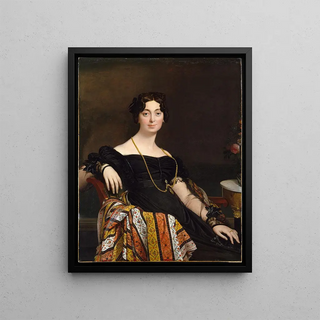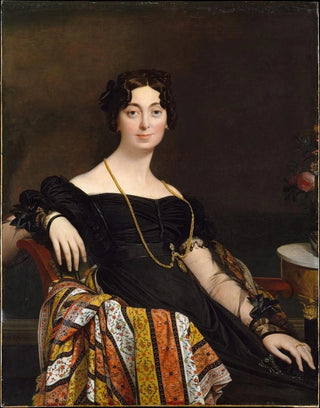Art print | Madame Jacques-Louis Leblanc Françoise Poncelle - Jean-Auguste-Dominique Ingres


View from behind

Frame (optional)
In the fascinating world of academic painting, the art print "Madame Jacques-Louis Leblanc Françoise Poncelle" by Jean Auguste Dominique Ingres stands out for its timeless grace and refinement. Created in the early 19th century, this canvas embodies the very essence of neoclassicism, an artistic movement that seeks to rediscover the purity and beauty of ancient forms. Ingres, an undisputed master of female representation, manages to capture not only the physical appearance of his model but also a psychological depth that transcends mere portraiture. The composition, both rigorous and delicate, draws the eye and invites prolonged contemplation, thus revealing the richness of details and the subtlety of emotions.
Style and uniqueness of the work
The piece is characterized by an exceptional mastery of lines and colors. Ingres, a true virtuoso, plays with shadows and lights to bring Françoise Poncelle to life, whose face expresses an almost divine serenity. The chosen palette, dominated by warm and soft tones, enhances the natural beauty of the model, while the drapery of her clothing, meticulously painted, testifies to unparalleled craftsmanship. Every fold, every reflection seems carefully thought out to add an extra dimension to the figure. Ingres does not merely reproduce an image; he creates an atmosphere, a world where elegance and dignity intertwine. This portrait, in sum, is an ode to femininity, beauty, and art itself.
The artist and his influence
Jean Auguste Dominique Ingres, born in 1780, is one of the emblematic figures of French neoclassicism. His artistic journey is marked by an incessant quest for perfection and a desire to reinterpret the great masters of the past. Strongly influenced by artists such as Raphael and Poussin, Ingres develops a style that is uniquely his own, combining academic rigor with personal sensitivity. Beyond his portraits, he also excels in historical and mythological compositions, where he explores universal themes with a unique approach.

Matte finish

View from behind

Frame (optional)
In the fascinating world of academic painting, the art print "Madame Jacques-Louis Leblanc Françoise Poncelle" by Jean Auguste Dominique Ingres stands out for its timeless grace and refinement. Created in the early 19th century, this canvas embodies the very essence of neoclassicism, an artistic movement that seeks to rediscover the purity and beauty of ancient forms. Ingres, an undisputed master of female representation, manages to capture not only the physical appearance of his model but also a psychological depth that transcends mere portraiture. The composition, both rigorous and delicate, draws the eye and invites prolonged contemplation, thus revealing the richness of details and the subtlety of emotions.
Style and uniqueness of the work
The piece is characterized by an exceptional mastery of lines and colors. Ingres, a true virtuoso, plays with shadows and lights to bring Françoise Poncelle to life, whose face expresses an almost divine serenity. The chosen palette, dominated by warm and soft tones, enhances the natural beauty of the model, while the drapery of her clothing, meticulously painted, testifies to unparalleled craftsmanship. Every fold, every reflection seems carefully thought out to add an extra dimension to the figure. Ingres does not merely reproduce an image; he creates an atmosphere, a world where elegance and dignity intertwine. This portrait, in sum, is an ode to femininity, beauty, and art itself.
The artist and his influence
Jean Auguste Dominique Ingres, born in 1780, is one of the emblematic figures of French neoclassicism. His artistic journey is marked by an incessant quest for perfection and a desire to reinterpret the great masters of the past. Strongly influenced by artists such as Raphael and Poussin, Ingres develops a style that is uniquely his own, combining academic rigor with personal sensitivity. Beyond his portraits, he also excels in historical and mythological compositions, where he explores universal themes with a unique approach.






